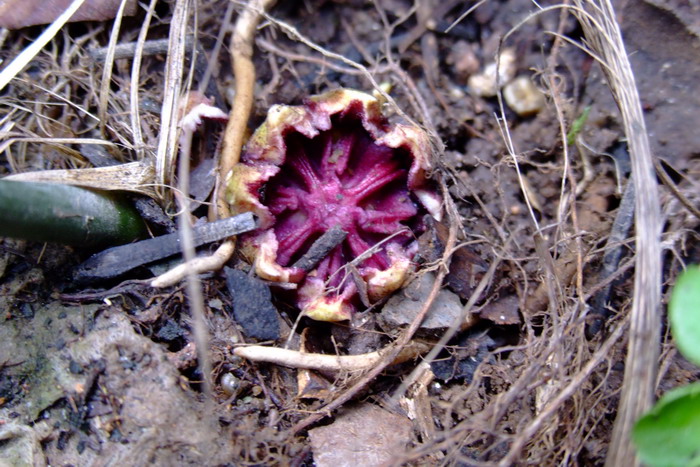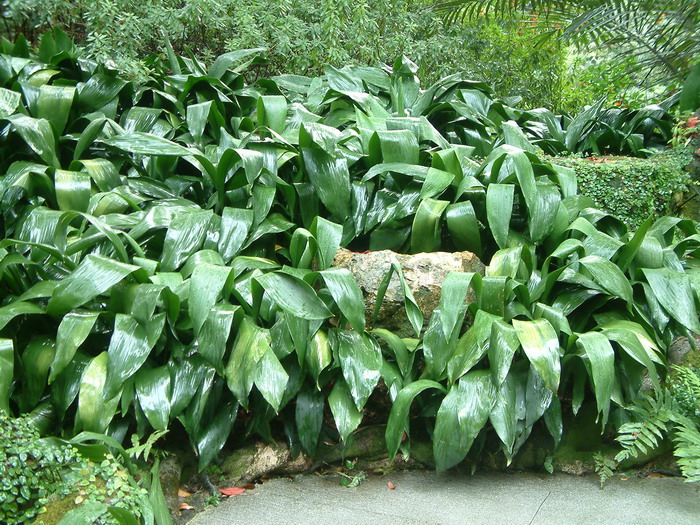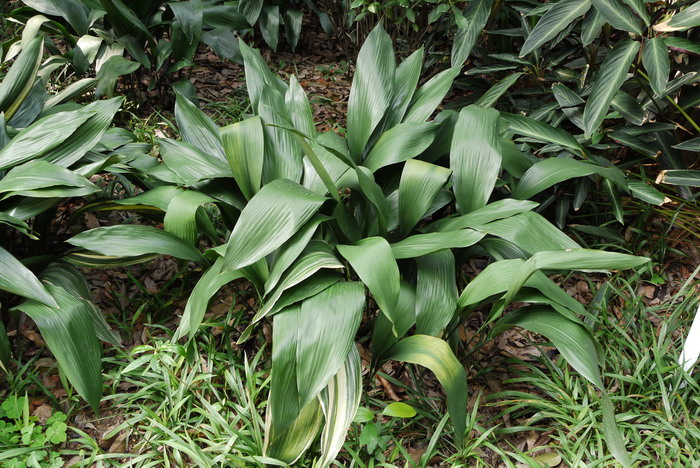蜘蛛抱蛋Aspidistra elatior
中文名(Chinese Name):蜘蛛抱蛋
学名(Scientific Name):Aspidistra elatior Bl.
英文名(English Common Name):
别名(Chinese Common Name):一叶兰
异名(Synonym):Aspidistra punctata var. albomaculata Hook. Plectogyne variegata Link
科属(Family & Genus):百合科(Liliaceae)蜘蛛抱蛋属
形态特征(Description):根状茎近圆柱形,直径5-10毫米,具节和鳞片。叶单生,彼此相距1-3厘米, 矩圆状披针形、披针形至近椭圆形,长22-46厘米,宽8-11厘米,先端渐尖,基部楔形,边缘多少皱波状,两面绿色,有时稍具黄白色斑点或条纹;叶柄明显,粗壮,长5-35厘米。总花梗长0.5-2厘米;苞片3-4枚,其中2枚位于花的基部,宽卵形,长7-10毫米,宽约9毫米,淡绿色,有时有紫色细点;花被钟状,长12-18毫米,直径10-15毫米,外面带紫色或暗紫色,内面下部淡紫色或深紫色,上部(6-)8裂;花被筒长10-12毫米.裂片近三角形,向外扩展或外弯,长6-8毫米,宽3.5-4毫米,先端钝,边缘和内侧的上部淡绿色,内面具条特别肥厚的肉质脊状隆起,中间的2条细而长,两侧的2条粗而短,中部高达1.5毫米,紫红色;雄蕊(6-)8枚,生于花被筒近基部,低于柱头;花丝短,花药椭圆形,长约2毫米;雌蕊高约8毫米,子房几不膨大;花柱无关节;柱头盾状膨大,圆形,直径10-13毫米,紫红色,上面具(3-)4深裂,裂缝两边多少向上凸出,中心部分微凸,裂片先端微凹,边缘常向上反卷。
分布(Distribution):我国各地公园多有栽培,原产地不详。
用途(Use):
引自植物志英文版:FOC Vol. 24 Page 246
Aspidistra elatior Blume, Tijdschr. Natuuri. Gesch. Physiol. 1: 76. 1834.
蜘蛛抱蛋 zhi zhu bao dan | Liliaceae | Aspidistra
Aspidistra punctata Lindley var. albomaculata Hooker; Plectogyne variegata Link.
Rhizome subterete, 5--10 mm thick. Leaves solitary, spaced; petiole 5--35 cm, stiff; leaf blade sometimes with yellowish white markings, oblong-lanceolate, lanceolate, or subelliptic, 20--45 × 6--10 cm. Scape 0.5--2 cm; bracts 2--4. Flower solitary. Perianth purplish to dark-purple, rarely pinkish, campanulate, (6--)8-lobed apically; tube 1--1.2 × 1--1.5 cm; lobes greenish at margin, deltoid, 6--8 × 3.5--4 mm, adaxially 4-keeled, keels purple-red, very thick, fleshy, smooth, central 2 up to 1.5 mm wide. Stamens (6--)8, inserted at base of perianth tube, subsessile; anthers elliptic, ca. 2 mm. Pistil ca. 8 mm; stigma peltate, orbicular, large, 1--1.3 cm in diam., 4-lobed at margin, lobes emarginate at apex. Fl. Jan--Apr. 2 n = 36*.
Widely cultivated in China [native to Japan (Osumi Islands)].
Aspidistra elatior was said to be of Chinese origin, but no wild plants have been found in China. Sako and Maruno (Bull. Kagoshima Univ. For. 11: 33--78. 1983) and Sako et al. (ibid. 16: 83--108. 1988) noted that the species originated from Kuroshima, Suwanose, and Uji Islands (Osumi Islands, S of Kyushu, Japan). The Uji Islands are largely covered with thickets of Ardisia sieboldii Miquel, where Aspidistra elatior grows abundantly. Kuroshima Island is largely covered with forests of Castanopsis sieboldii (Makino) Hatusima ex T. Yamazaki & Mashiba, the understory of which is occupied by A. elatior.



(责任编辑:徐晔春)
学名(Scientific Name):Aspidistra elatior Bl.
英文名(English Common Name):
别名(Chinese Common Name):一叶兰
异名(Synonym):Aspidistra punctata var. albomaculata Hook. Plectogyne variegata Link
科属(Family & Genus):百合科(Liliaceae)蜘蛛抱蛋属
形态特征(Description):根状茎近圆柱形,直径5-10毫米,具节和鳞片。叶单生,彼此相距1-3厘米, 矩圆状披针形、披针形至近椭圆形,长22-46厘米,宽8-11厘米,先端渐尖,基部楔形,边缘多少皱波状,两面绿色,有时稍具黄白色斑点或条纹;叶柄明显,粗壮,长5-35厘米。总花梗长0.5-2厘米;苞片3-4枚,其中2枚位于花的基部,宽卵形,长7-10毫米,宽约9毫米,淡绿色,有时有紫色细点;花被钟状,长12-18毫米,直径10-15毫米,外面带紫色或暗紫色,内面下部淡紫色或深紫色,上部(6-)8裂;花被筒长10-12毫米.裂片近三角形,向外扩展或外弯,长6-8毫米,宽3.5-4毫米,先端钝,边缘和内侧的上部淡绿色,内面具条特别肥厚的肉质脊状隆起,中间的2条细而长,两侧的2条粗而短,中部高达1.5毫米,紫红色;雄蕊(6-)8枚,生于花被筒近基部,低于柱头;花丝短,花药椭圆形,长约2毫米;雌蕊高约8毫米,子房几不膨大;花柱无关节;柱头盾状膨大,圆形,直径10-13毫米,紫红色,上面具(3-)4深裂,裂缝两边多少向上凸出,中心部分微凸,裂片先端微凹,边缘常向上反卷。
分布(Distribution):我国各地公园多有栽培,原产地不详。
用途(Use):
引自植物志英文版:FOC Vol. 24 Page 246
Aspidistra elatior Blume, Tijdschr. Natuuri. Gesch. Physiol. 1: 76. 1834.
蜘蛛抱蛋 zhi zhu bao dan | Liliaceae | Aspidistra
Aspidistra punctata Lindley var. albomaculata Hooker; Plectogyne variegata Link.
Rhizome subterete, 5--10 mm thick. Leaves solitary, spaced; petiole 5--35 cm, stiff; leaf blade sometimes with yellowish white markings, oblong-lanceolate, lanceolate, or subelliptic, 20--45 × 6--10 cm. Scape 0.5--2 cm; bracts 2--4. Flower solitary. Perianth purplish to dark-purple, rarely pinkish, campanulate, (6--)8-lobed apically; tube 1--1.2 × 1--1.5 cm; lobes greenish at margin, deltoid, 6--8 × 3.5--4 mm, adaxially 4-keeled, keels purple-red, very thick, fleshy, smooth, central 2 up to 1.5 mm wide. Stamens (6--)8, inserted at base of perianth tube, subsessile; anthers elliptic, ca. 2 mm. Pistil ca. 8 mm; stigma peltate, orbicular, large, 1--1.3 cm in diam., 4-lobed at margin, lobes emarginate at apex. Fl. Jan--Apr. 2 n = 36*.
Widely cultivated in China [native to Japan (Osumi Islands)].
Aspidistra elatior was said to be of Chinese origin, but no wild plants have been found in China. Sako and Maruno (Bull. Kagoshima Univ. For. 11: 33--78. 1983) and Sako et al. (ibid. 16: 83--108. 1988) noted that the species originated from Kuroshima, Suwanose, and Uji Islands (Osumi Islands, S of Kyushu, Japan). The Uji Islands are largely covered with thickets of Ardisia sieboldii Miquel, where Aspidistra elatior grows abundantly. Kuroshima Island is largely covered with forests of Castanopsis sieboldii (Makino) Hatusima ex T. Yamazaki & Mashiba, the understory of which is occupied by A. elatior.
(责任编辑:徐晔春)
踩一下[2]

顶一下[6]